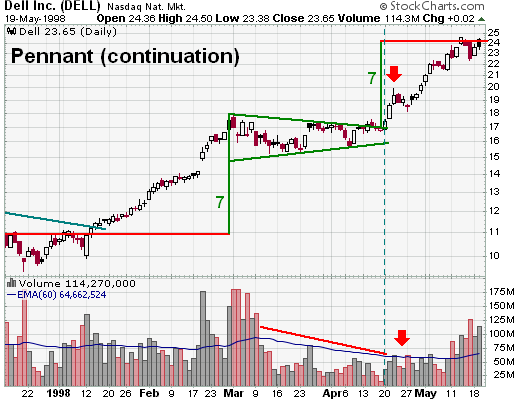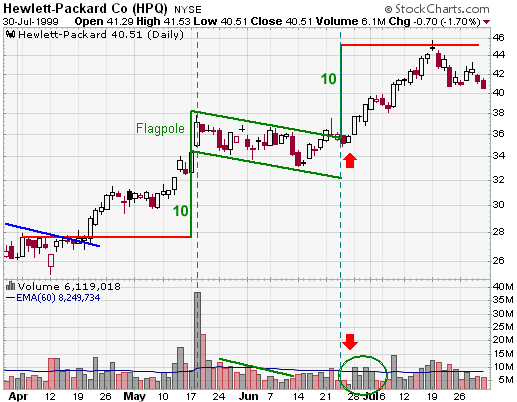|
|
Table of Contents
Flag, Pennant
What Are Flag and Pennant Chart Patterns?
Flags and Pennants are short-term continuation patterns that mark a small consolidation before the previous move resumes. These patterns are usually preceded by a sharp advance or decline with heavy volume, and mark a midpoint of the move.

- Sharp Move. To be considered a continuation pattern, there should be evidence of a prior trend. Flags and pennants require evidence of a sharp advance or decline in heavy volume. These moves usually occur on heavy volume and can contain gaps. This move usually represents the first leg of a significant advance or decline, and the flag/pennant is merely a pause.
- Flagpole. The flagpole is the distance from the first resistance or support break to the high or low of the flag/pennant. The sharp advance (or decline) that forms the flagpole should break a trend line or resistance/support level. A line extending up from this break to the high of the flag/pennant forms the flagpole.
- Flag. A flag is a small rectangle pattern that slopes against the previous trend. If the previous move was up, then the flag would slope down. If the move was down, then the flag would slope up. Because flags are usually too short in duration to actually have reaction highs and reaction lows, the price action just needs to be contained within two parallel trend lines.
- Pennant. A pennant is a small symmetrical triangle that begins wide and converges as the pattern matures (like a cone). The slope is usually neutral. Sometimes there will not be specific reaction highs and lows from which to draw the trend lines, and the price action should be contained within the converging trend lines.
- Duration: Flags and pennants are short-term patterns lasting from one to 12 weeks. There is some debate on the timeframe, and some consider eight weeks to be pushing the limits for a reliable pattern. Ideally, these patterns will form between one and four weeks. Once a flag is over 12 weeks old, it would be classified as a rectangle. A pennant more than 12 weeks old would turn into a symmetrical triangle. The reliability of patterns that fall between eight and 12 weeks is debatable.
- Break. For a bullish flag or pennant, a break above resistance signals that the previous advance has resumed. For a bearish flag or pennant, a break below support signals that the previous decline has resumed.
- Volume. Volume should be heavy during the advance or decline that forms the flagpole. Heavy volume provides legitimacy for the sudden and sharp move that creates the flagpole. An expansion of volume on the resistance (support) break lends credence to the validity of the formation and the likelihood of continuation.
- Targets. The flagpole length can be applied to the resistance break or support break of the flag/pennant to estimate the advance or decline.
How Do You Identify Flags and Pennants?
Even though flags and pennants are common formations, identification guidelines should not be taken lightly. It is important that flags and pennants are preceded by a sharp advance or decline. Without a sharp move, the reliability of the formation becomes questionable and trading could carry added risk. Look for volume confirmation on the initial move, consolidation and resumption to augment the robustness of pattern identification.

HPQ provides an example of a flag that forms after a sharp and sudden advance.
- Sharp Move. After consolidating for three months, HPQ broke above resistance at 28 to begin a sharp advance. The 5-April high and 16-Feb trend line marked resistance and the breakout occurred with a volume expansion. The stock advanced from 28 to 38 in a mere 4 weeks. (Note: It is also possible that a small pennant formed in early May with resistance around 31).
- Flagpole. The distance from the breakout at 28 to the flag's high at 38 formed the flagpole.
- Flag. Price action was contained within two parallel trend lines that sloped down.
- Duration. From a high at 38 to the breakout at 36, the flag formed over a 23-day period.
- Breakout. The first break above the flag's upper trend line occurred on 21-June without an expansion of volume. However, the stock gapped up a week later and closed strong with above-average volume (red arrows).
- Volume: To recap - volume expanded on the sharp advance to form the flagpole, contracted during the flag's formation and expanded right after the resistance breakout.
- Targets. The length of the flagpole measured 10 points and was applied to the resistance breakout at 36 to project a target of 46.
